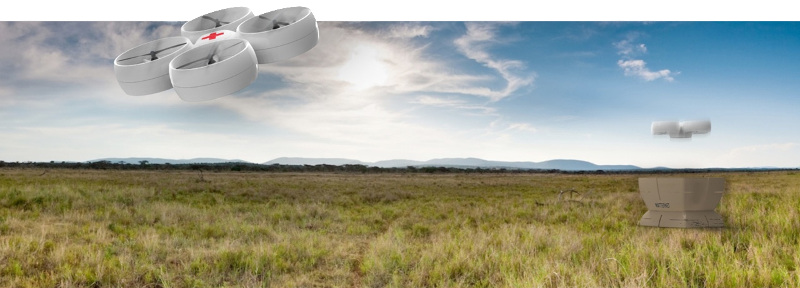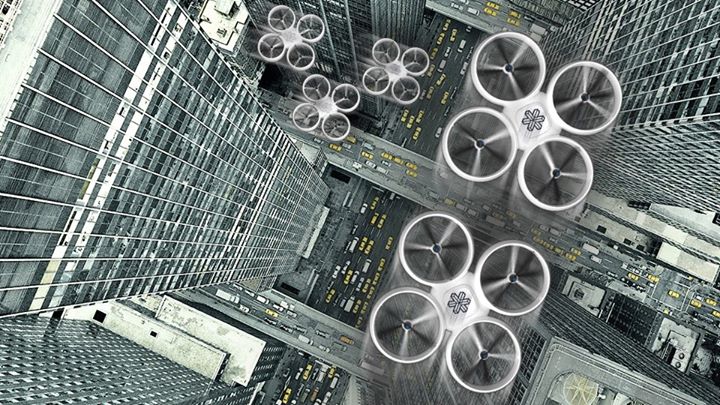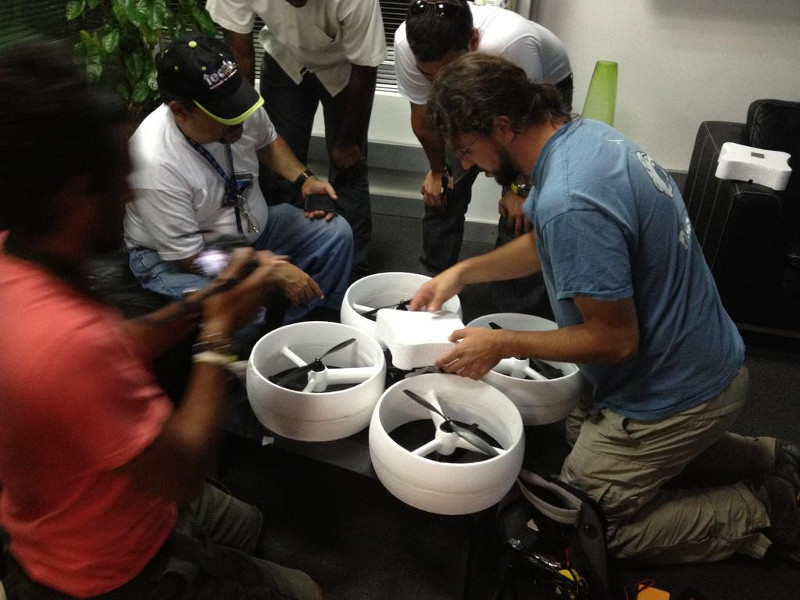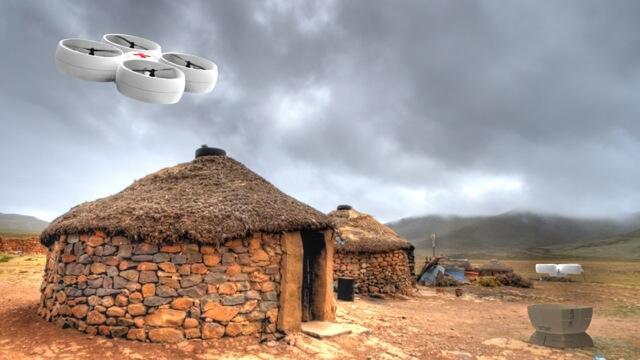Matternet wants to create a future transportation network
Recently, the Internet has bypassed the news that the startup Tacocopter plans to deal with the delivery of tacos using quadrocopters. So far, this is perceived simply as a whim and a desire to show off - the courier on a scooter is simpler and more reliable. But Matternet , which grew out of the Singularity University project, founded by Ray Kurzweil, approached the matter completely from the other side. She wants to create a transport network based on electric quadcopters where there are no couriers, no scooters and no roads.

Today, one billion people live in places that are several months a year (for example, during the rainy season, when the only dirt road leading to the city turns into a marsh) are completely cut off from civilization. Opportunities at any time to run to the store or pharmacy, which we take for granted, every seventh inhabitant of the planet is deprived. But after all, life may depend on the packaging of a medicine or food ration for several days. Not to mention that without the ability to conduct regular trade with the rest of the world, the inhabitants of such places are doomed to chronic poverty.
Matternet plans to create a network for delivering small packages using UAVs with a range of about ten kilometers and a payload of up to several kilograms (for a start). Their batteries will be automatically replaced at charging stations located at ten-kilometer intervals. The stations will be completely autonomous and maintenance-free, except in the case of unavoidable repairs. To recharge batteries, they will use solar panels or wind turbines. To establish a chain of such stations connecting the city with a remote village is several orders of magnitude cheaper than building a decent road. The construction of a one-lane kilomete on average costs half a million dollars. For this money, you can install a network of several dozen drones and base stations.
')
In addition to places completely devoid of transport infrastructure, Matternet can be very useful where existing infrastructure does not cope with the load. So, the Brazilian megalopolis of São Paulo, with a population of 20 million people (if you count the suburbs), is literally suffocating in traffic jams. A small army of 250,000 motorcycles and scooters is engaged in fast delivery of small loads. In an accident with their participation about 500 people die annually. A network of UAVs could save millions of hours lost in traffic and save many lives.

Matternet can be the first fully automated P2P transport system across countries and continents. If the first projects of the introduction of Matternet will be successful, the next stage of development will begin the development of more lifting drones, and in the longer term - even passenger aircraft.
Almost all components of this network do not go beyond the capabilities of today's technologies. Quadrocopters and even unmanned airplanes already know how to land and take off and perform complex maneuvers, enough battery capacity to fly several kilometers, solar panels and wind energy are already familiar and quite reliable. The only truly new and unique element of the system will be a distributed operating system that will manage the network of drones in real time, optimizing the flow of goods taking into account the weather and transportation needs, just as routers on the Internet control the flow of information packets.

Now Matternet drone prototypes are undergoing field tests in the Dominican Republic and at one of NASA's test sites in the USA. The startup is funded by the Andreessen Horowitz venture fund. One of the first real-world applications of Matternet could be the delivery of HIV test results and AIDS vaccines to Lesotho residents. It is no coincidence that it is Africa that is increasingly becoming a place where the latest technologies are being tested - there is no infrastructure here that has been created in more developed countries for decades, and building everything from scratch on the basis of the latest technologies turns out to be the most advantageous. It is easy to meet people who constantly use a mobile phone, but they hardly imagine what a stationary looks like. There are mobile phones even in remote villages where there is no electricity: they are charged from a diesel generator. In addition, there are much less legal problems. For example, in the US, flights of commercial UAVs are not yet allowed at all.

According to the African Development Bank, Africa is on the verge of an alternative energy boom - gradually increasing the number of wind turbines and solar panels here is often more profitable than building large and expensive traditional power plants and hundreds of kilometers of power lines. In Africa, Google intends to deploy a large-scale network of wireless Internet access stations covering an enormous area thanks to the placement of equipment on balloons and airships. It is not surprising that the Matternet futuristic transport network is going to take its first steps here, and only then seize more developed countries.
Matternet co-founder Andreas Raptopoulos speaks on Google Solve for X

Today, one billion people live in places that are several months a year (for example, during the rainy season, when the only dirt road leading to the city turns into a marsh) are completely cut off from civilization. Opportunities at any time to run to the store or pharmacy, which we take for granted, every seventh inhabitant of the planet is deprived. But after all, life may depend on the packaging of a medicine or food ration for several days. Not to mention that without the ability to conduct regular trade with the rest of the world, the inhabitants of such places are doomed to chronic poverty.
Matternet plans to create a network for delivering small packages using UAVs with a range of about ten kilometers and a payload of up to several kilograms (for a start). Their batteries will be automatically replaced at charging stations located at ten-kilometer intervals. The stations will be completely autonomous and maintenance-free, except in the case of unavoidable repairs. To recharge batteries, they will use solar panels or wind turbines. To establish a chain of such stations connecting the city with a remote village is several orders of magnitude cheaper than building a decent road. The construction of a one-lane kilomete on average costs half a million dollars. For this money, you can install a network of several dozen drones and base stations.
')
In addition to places completely devoid of transport infrastructure, Matternet can be very useful where existing infrastructure does not cope with the load. So, the Brazilian megalopolis of São Paulo, with a population of 20 million people (if you count the suburbs), is literally suffocating in traffic jams. A small army of 250,000 motorcycles and scooters is engaged in fast delivery of small loads. In an accident with their participation about 500 people die annually. A network of UAVs could save millions of hours lost in traffic and save many lives.

Matternet can be the first fully automated P2P transport system across countries and continents. If the first projects of the introduction of Matternet will be successful, the next stage of development will begin the development of more lifting drones, and in the longer term - even passenger aircraft.
Almost all components of this network do not go beyond the capabilities of today's technologies. Quadrocopters and even unmanned airplanes already know how to land and take off and perform complex maneuvers, enough battery capacity to fly several kilometers, solar panels and wind energy are already familiar and quite reliable. The only truly new and unique element of the system will be a distributed operating system that will manage the network of drones in real time, optimizing the flow of goods taking into account the weather and transportation needs, just as routers on the Internet control the flow of information packets.

Now Matternet drone prototypes are undergoing field tests in the Dominican Republic and at one of NASA's test sites in the USA. The startup is funded by the Andreessen Horowitz venture fund. One of the first real-world applications of Matternet could be the delivery of HIV test results and AIDS vaccines to Lesotho residents. It is no coincidence that it is Africa that is increasingly becoming a place where the latest technologies are being tested - there is no infrastructure here that has been created in more developed countries for decades, and building everything from scratch on the basis of the latest technologies turns out to be the most advantageous. It is easy to meet people who constantly use a mobile phone, but they hardly imagine what a stationary looks like. There are mobile phones even in remote villages where there is no electricity: they are charged from a diesel generator. In addition, there are much less legal problems. For example, in the US, flights of commercial UAVs are not yet allowed at all.

According to the African Development Bank, Africa is on the verge of an alternative energy boom - gradually increasing the number of wind turbines and solar panels here is often more profitable than building large and expensive traditional power plants and hundreds of kilometers of power lines. In Africa, Google intends to deploy a large-scale network of wireless Internet access stations covering an enormous area thanks to the placement of equipment on balloons and airships. It is not surprising that the Matternet futuristic transport network is going to take its first steps here, and only then seize more developed countries.
Matternet co-founder Andreas Raptopoulos speaks on Google Solve for X
Source: https://habr.com/ru/post/181139/
All Articles